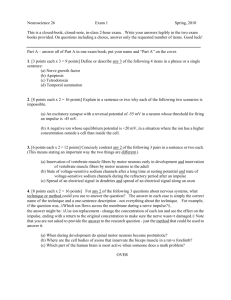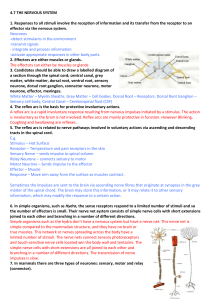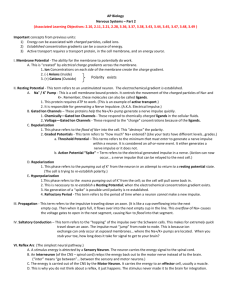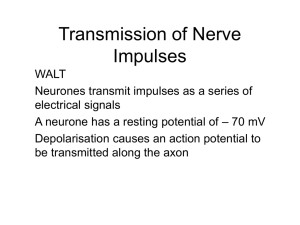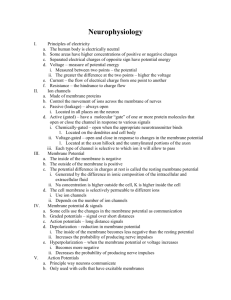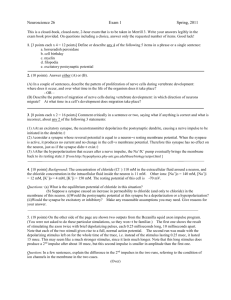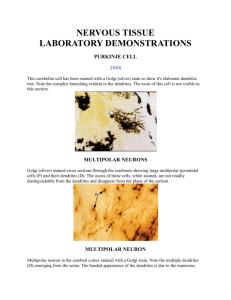Nerves and Hearts:
advertisement
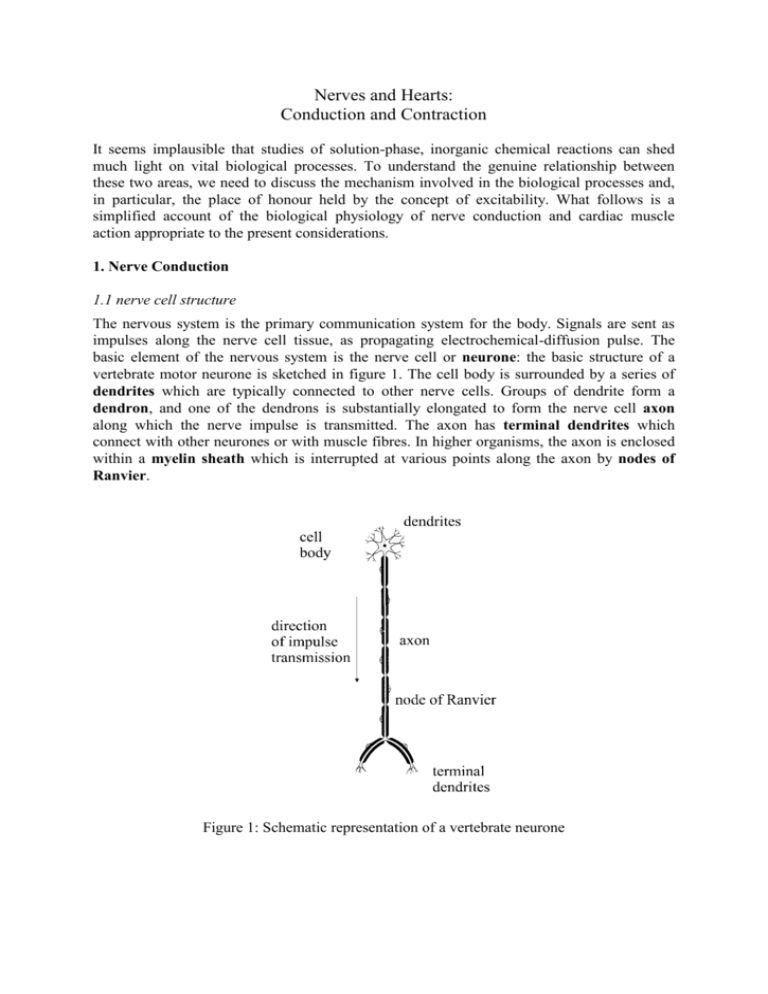
Nerves and Hearts: Conduction and Contraction It seems implausible that studies of solution-phase, inorganic chemical reactions can shed much light on vital biological processes. To understand the genuine relationship between these two areas, we need to discuss the mechanism involved in the biological processes and, in particular, the place of honour held by the concept of excitability. What follows is a simplified account of the biological physiology of nerve conduction and cardiac muscle action appropriate to the present considerations. 1. Nerve Conduction 1.1 nerve cell structure The nervous system is the primary communication system for the body. Signals are sent as impulses along the nerve cell tissue, as propagating electrochemical-diffusion pulse. The basic element of the nervous system is the nerve cell or neurone: the basic structure of a vertebrate motor neurone is sketched in figure 1. The cell body is surrounded by a series of dendrites which are typically connected to other nerve cells. Groups of dendrite form a dendron, and one of the dendrons is substantially elongated to form the nerve cell axon along which the nerve impulse is transmitted. The axon has terminal dendrites which connect with other neurones or with muscle fibres. In higher organisms, the axon is enclosed within a myelin sheath which is interrupted at various points along the axon by nodes of Ranvier. Figure 1: Schematic representation of a vertebrate neurone 1.2 mechanism of nerve impulse transmission The mechanism of nerve impulse transmission along the axon has been established from the seminal work of Hodgkin and Huxley, who investigated this process in the giant axon of the squid who recorded the potential across the axon membrane by placing a very fine microelectrode inside the axon and a second on the external surface of the membrane. In the resting state, when the nerve is not transmitting an impulse, a resting potential of approximately 60 mV is maintained across the membrane, with the inside of the axon being negative with respect to the outside. The membrane is said to be polarized. This potential arises from the distribution of anions and cations across the membrane, with there being an excess of Na+ cations outside the axon and an excess of K+ and the organic anions on the inside. As an impulse passes along the axon, so there is a local reversal of this potential (and of the ion distribution): the membrane becomes depolarized and an action potential of approximately +60 mV develops, with the inside of the axon now being positive with respect to its surroundings. The action potential lasts for about 1 ms after which the system recovers to its resting potential. During the depolarization, the membrane becomes permeable to Na+ ions, which thus flow into the axon. The sodium ion distribution is regained through the action of ion pumps which selectively transport Na+ cations across the membrane. The propagation of an impulse through this depolarization and repolarization is sketched in Figure 2. Notice the characteristic feature of a constant form wave which also propagates with a constant velocity. Figure 2: propagation of a nerve impulse along a nerve axon 1.3 excitability and speed of transmission Nerve tissue exhibits all the classic features of an excitable medium. It has a stable resting state, the stimulus required to initiate an impulse must exceed a certain threshold, following the passage of an impulse, the membrane is locally refractory until excitability is recovered. The total refractory period lasts approximately 3 ms, being comprised of an absolute refractory phase of ca. 0.5 ms and then a relative refractory period in which the membrane can be re-excited only by very large amplitude stimuli. The transmission speed of nerve impulses may vary from 0.5 m s1 to over 100 m s1 depending on the type of tissue involved. Invertebrate animals do not typically have a myelin sheath surrounding the axon. The speed in these cases is then primarily determined by the axon diameter - with a larger diameter giving a higher speed. The giant axon cells are usually associated with rapid escape responses. In vertebrates, higher transmission speeds are attained with the myelinated nerve cells. The sheath is interrupted at approximately 1 mm intervals by the nodes of Ranvier and it is at these nodes that the depolarization occurs, ‘jumping’ from one to the next rather than traversing the whole of the axon length. 1.4 quantitative models for nerve action A quantitative model of nerve impulse transmission was constructed by Hodgkin and Huxley based on the above mechanism. They wrote down an equation for the rate of change of the potential across the membrane in the form C dV I IK I Na I L dt (1) where I is the total current, IK and INa are the ion currents for K+ and Na+ and IL is a ‘leakage current’ arising from other ion transport across the membrane. On the basis of the experimental observations, the ion currents were written in the form I K gK n 4 V VK INa gNa m3hV VNa and I L gL V VL (2) where the gi and Vi are ‘known’ constants representing the conductances and equilibrium potentials of the ions. The remaining quantities, h, m and n are variables determined by the following differential equations: dh h V 1 h h V h dt dm m V 1 m m V m dt dn n V 1 n n V n dt (3a) (3b) (3c) The six, voltage-dependent functions i and i are again empirical fits to the data obtained by Hodgkin and Huxley. The rest state is that with no net current, i.e. I = 0 in equation (1) but the experiment can be performed with a constant, imposed non-zero current so as to obtain the various parameters. A simplification of the Hodgkin-Huxley equations that retains their essential characteristics has been given by FitzHugh and by Nagumo, noting that m is a ‘fast variable’ so that equation (3b) can be solved for m such that the right-hand side is equal to zero and by also taking h as a fixed constant value. The FitzHugh-Nagumo equations can be written in the form dv v a v v 1 w Ia dt dw bv w dt (4a) (4b) where v is a scaled version of the potential V and w involves m, n and h. The first term on the right-hand side of equation (4a) has a cubic form similar to that seen in the kinetic equations for the Belousov-Zhabotinsky reaction. Further levels of approximation replace this with a series of linear terms (the piecewise linear approximation) and still capture the generic features of an excitable system. 1.5 transmission of impulses between cells The transmission of impulses from one neurone to another occurs through a connection known as a synapse. Synaptic transmission has a chemical nature and ensures that nerve impulses travel in only one direction along the nervous system. At the end of each dendrite is the synaptic knob in which are held sac-like vesicles that contain an transmitter substance, typically acetylcholine (ACh). Between the knob and the next cell is the synaptic cleft, bounded by the pre-synaptic and post-synaptic membranes, see Figure 3. The arrival of an impulse at the end of the axon and into the dendrite, stimulates a vesicle to attach itself to the pre-synaptic membrane allowing the transmitter substance to diffuse into the synaptic cleft and attach itself to receptor sites on the post-synaptic membrane, causing a local depolarization and creating an excitatory post-synaptic potential (EPSP). Subsequent impulses cause further increases in the EPSP and if this reaches the appropriate threshold value, an impulse is initiated in the new cell. This transmission mechanism may cause a significant delay (ca. 1 ms) in the transmission of the impulse between cells. The build-up of the transmitter substance concentration in the synaptic cleft is regulated by an enzyme, cholinesterase, which allows for the ‘resetting’ of the membrane. The mechanism of transmission from a neurone to a muscle fibre is essentially the same, occurring through a neuromuscular synaptic connection. Figure 3:schematic representation of a synapse Drugs and poisons can affect the nerve impulse transmission by interfering with the synaptic chemistry. Atropine prevents ACh from depolarizing the post-synaptic membrane (presumably by blocking the receptor sites) between neurones and curare plays a similar role specifically at nerve-muscle junctions. Eserine facilitates synaptic transmission by preventing the action of cholinesterase as does, more dramatically, strychnine which causes convulsive contractions of muscles. Other chemical transmitter substances include noradrenaline, which has a similar action in the sympathetic nervous system, such as the human brain, and is controlled by the enzyme mono-aminoxidase. Drugs such as mescaline and LSD are thought to interfere with the noradrenaline action. 2. Heart Muscle Contraction 2.1 basic structure of the heart The mammalian heart consists of four chambers: the left and right atria and the left and right ventricles. The healthy heart undergoes rhythmic systolic contraction and diastolic relaxation. Deoxygenated blood returns from the body to the right atrium via the vanae cavae (‘great veins’). The increase in pressure in this chamber causes the atrio-vetricular valve to open so the blood flows into the right ventricle. A contraction of the right atrium forces more blood into the ventricle and the contraction then spreads across the rest of the heart. The subsequent ventricular contraction is much stronger than the atrial systole and forces blood out through the pulmony artery to the lungs. Oxygenated blood then returns through the pulmonary vein to the left atrium and is pumped by similar contractions through the left ventricle out via the dorsal aorta to the body, as indicated in Figure 4. The heart refills with blood during the diastolic relaxation phase. Figure 4: schematic representation of arterial and vein systems 2.2 mechanism of cardiac cycle The ionic-basis of impulse transmission through an excitable medium described above for nerves is also thought to operate in muscle tissue. In the case of muscle fibres, however, it is also accompanied by a mechanical contraction of the tissue. Skeletal muscle contracts only on stimulation. Cardiac muscle, however, is significantly different in that it undergoes spontaneous, rhythmic (myogenic) contractions generated from within the muscle tissue itself. It consists of a network of interconnected fibres across which electrical impulses of excitation propagate. Embedded within the wall of the right atrium, close to the entrance point of the venae cavae, is the sino-atrial node (SAN), a specialised collection of muscle fibres with a natural oscillatory frequency of approximately 70 beats per minute (adult human heart). The surrounding atrial tissue has a lower oscillatory frequency of ca. 60 beats per minute and ventricular tissue has a much lower spontaneous frequency of ca. 25 beats per minute. The SAN thus acts as a pacemaker site for the heart. The electrical excitation originates from the SAN and propagates over the atria. When it reaches the junction between the atria and the ventricles, it excites another specialized group of fibres known as the atrioventricular node (AVN), Figure 5. Figure 5: schematic representation of mammalian heart indicating spread of excitation from sino-atrial node. The excitation signal is then transmitted rapidly along a bundle of modified cardiac fibres known as the Purkinje tissue which spreads out across the wall of the ventricles into which the excitation spreads to cause the ventricular contraction. The whole rhythmic process is controlled by the SAN tissue and can occur quite independently of the nervous system (although the nerves can play a role in modifying the basic pacemaker frequency, adjusting the heart beat rate in response to the environment as necessary). The variations of cardiac pressure and volume and the associated electrocardiogram (ECG) record through one cardiac cycle are sketched in Figure 6. Figure 6: variation of pressure, cardiac volume and ECG record during normal heart beat
